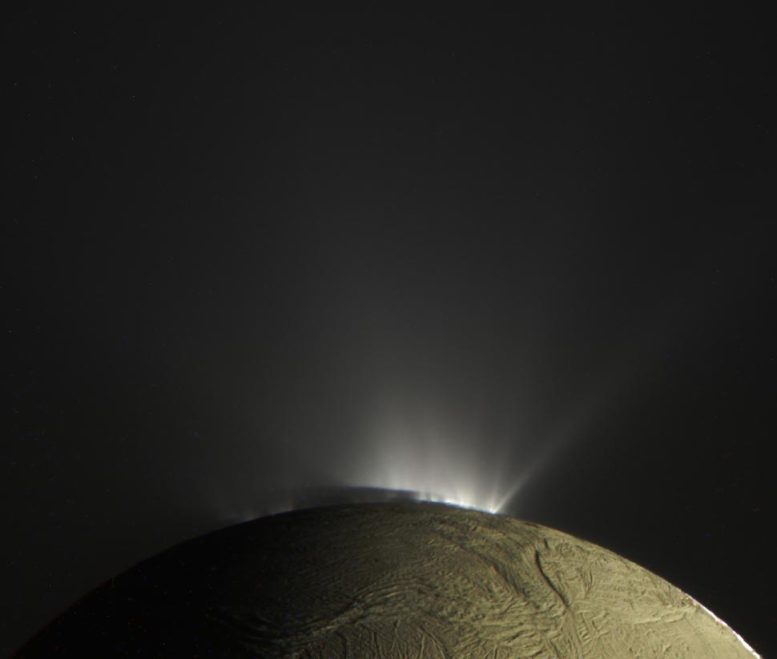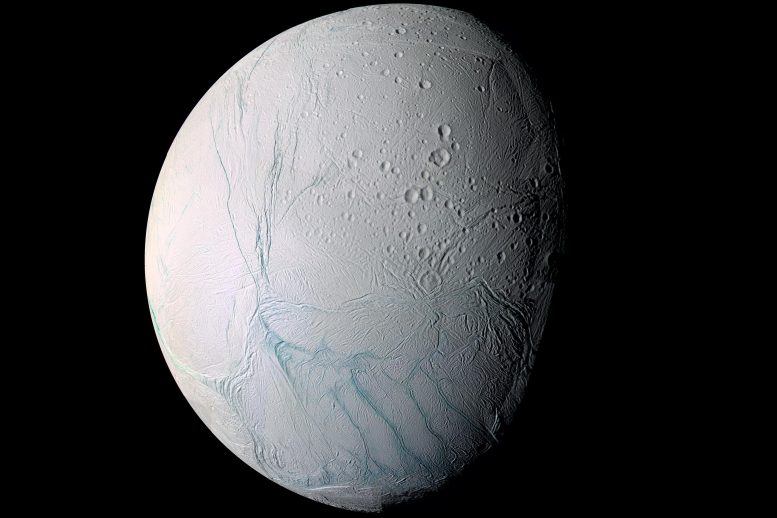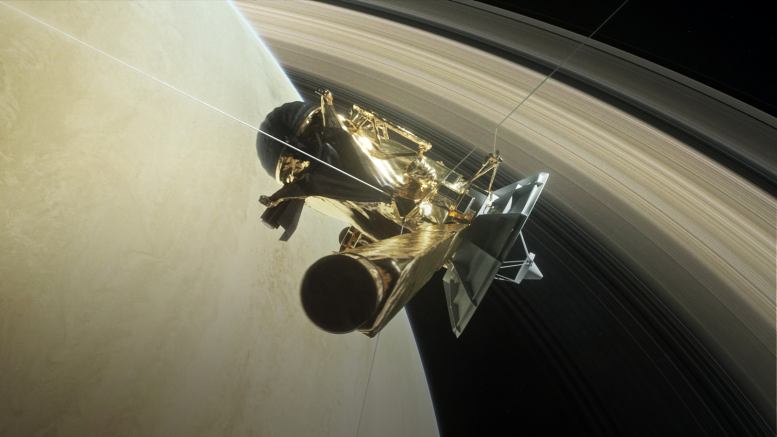
Researchers from Freie Universität Berlin have discovered phosphorus in the subsurface ocean of Saturn’s moon Enceladus.
The search for extraterrestrial life in our solar system has just taken a giant leap forward. A team of researchers led by Professor Frank Postberg, a planetary scientist at Freie Universität Berlin, has discovered new evidence that the subsurface ocean of Saturn’s icy moon Enceladus contains a key building block for life. The international research team used data from the Cassini space mission to detect phosphorus in the form of phosphates in ice particles – originating from the moon’s ice-covered global ocean – that had been ejected into space by the moon’s cryo-volcanic plume. The study was published in the scientific journal Nature on Wednesday, June 14, 2023.
“Previous geochemical models were divided on the question of whether Enceladus’ ocean contains significant quantities of phosphates at all,” says Professor Postberg. “These Cassini measurements leave no doubt that substantial quantities of this essential substance are present in the ocean water.” Phosphorus in the form of phosphates is vital for all life on Earth. It is essential for the creation of DNA and RNA, cell membranes, and ATP (the universal energy carrier in cells) for example. Life as we know it would simply not exist without phosphates.
“By determining such high phosphate concentrations readily available in Enceladus’ ocean, we have now satisfied what is generally considered one of the strictest requirements in establishing whether celestial bodies are habitable,” says early-career researcher Dr. Fabian Klenner, who has since relocated to Seattle where he continues to conduct research at the University of Washington. “The next step is clear – we need to go back to Enceladus to see if the habitable ocean is actually inhabited,” adds Dr. Nozair Khawaja, a planetary scientist originally from Pakistan who is now firmly established at Freie Universität Berlin.

A few years ago the Cassini-Huygens spacecraft, which was deployed by NASA and ESA into Saturn’s orbit between 2004 and 2017, discovered Enceladus’ subsurface liquid water ocean and analyzed samples in a plume of ice grains and gases that erupt into space from cracks in the moon’s icy crust. In previous studies, Postberg’s team had already determined that Enceladus harbors a “soda ocean” (rich in dissolved carbonates) and contains a vast variety of reactive and sometimes complex organic compounds. They also found indications of hydrothermal environments on the seafloor.
However, the research team at Freie Universität Berlin only recently discovered unmistakable signatures of phosphates in the data. What is crucial for bioavailability is that the phosphates are not trapped in rocky minerals but dissolved in the ocean as salt. The phosphate concentrations were determined to be at least 100 to 1,000 times higher than in Earth’s oceans. To investigate how Enceladus could maintain such high phosphate concentrations in its ocean, lab experiments were conducted in cooperation with a team of researchers located in Japan (led by Professor Yasuhito Sekine) and the US (Dr. Christopher R. Glein).

“Our geochemical experiments and modeling demonstrate that such high phosphate concentrations result from enhanced phosphate mineral solubility, for which the specific conditions exist not only on Enceladus, but more generally throughout the entire outer solar system,” explains Postberg. “That’s great news for a number of ocean worlds outside of Jupiter.”
One of the most profound discoveries in planetary science over the past twenty-five years is that worlds with oceans beneath a surface layer of ice are common in our solar system. They contain considerably more water than all of the oceans on Earth combined and include the icy moons of Jupiter and Saturn like Ganymede, Titan, and Enceladus, as well as even more distant celestial bodies like Pluto. Planets with surface oceans like Earth must reside within a narrow range of distances from their host stars (in what is known as the “habitable zone”) to maintain temperatures at which water neither evaporates nor freezes. Worlds with an interior ocean like Enceladus, however, can occur over a much wider range of distances, greatly expanding the number of habitable worlds likely to exist across the galaxy.
For more on this discovery:
- Critical Ingredient for Life Discovered at Saturn’s Moon Enceladus
- Building Block for Life Discovered in Enceladus’ Ocean
- First Direct Evidence of Phosphorus on an Extraterrestrial Ocean World
Reference: “Detection of phosphates originating from Enceladus’s ocean” by Frank Postberg, Yasuhito Sekine, Fabian Klenner, Christopher R. Glein, Zenghui Zou, Bernd Abel, Kento Furuya, Jon K. Hillier, Nozair Khawaja, Sascha Kempf, Lenz Noelle, Takuya Saito, Juergen Schmidt, Takazo Shibuya, Ralf Srama and Shuya Tan, 14 June 2023, Nature.
DOI: 10.1038/s41586-023-05987-9
Professor Frank Postberg is head of Planetary Sciences and Remote Sensing at the Institute of Geological Sciences and led the “Detection of Phosphates Originating from Enceladus’ Ocean” study, which included six other employees from Freie Universität Berlin. By analyzing data from the Cassini-Huygens spacecraft’s Cosmic Dust Analyzer, the team was able to detect clear signatures from high concentrations of water-soluble sodium phosphates (such as Na2HPO4) in ice particles from Enceladus’s ocean. This ocean was already considered one of the most likely sites for the emergence of extraterrestrial life in the solar system on the basis of earlier studies because it is home to a variety of reactive and sometimes complex organic compounds as well as hydrothermal activity on the seafloor driven by tidal dissipation. Phosphorus was the missing piece of the puzzle in finally being able to deem Enceladus’ ocean a habitable environment. Life, however, has not yet been found on Enceladus with the limited capabilities of the Cassini spacecraft launched in 1997. The search will continue with future missions.